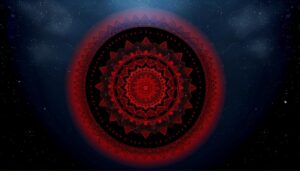Spiritual Meaning of Blue Flowers: Peace, Tranquility
Blue flowers, in their serene beauty, symbolize tranquility, deep spirituality, and a bridge to the divine across various cultures. They evoke the calming expanse of the sky and ocean, representing peace, wisdom, and spiritual enlightenment.
From the sacred blue lotus in Hinduism and ancient Egyptian beliefs to the mystical bluebell in Celtic lore, these blossoms embody harmony and inner peace. Their presence fosters reflective stillness, inviting personal transformation and deeper spiritual connections.
Enveloped in symbolism, blue flowers guide seekers toward hidden truths and cosmic unity, a journey rich with insights waiting to unfold.
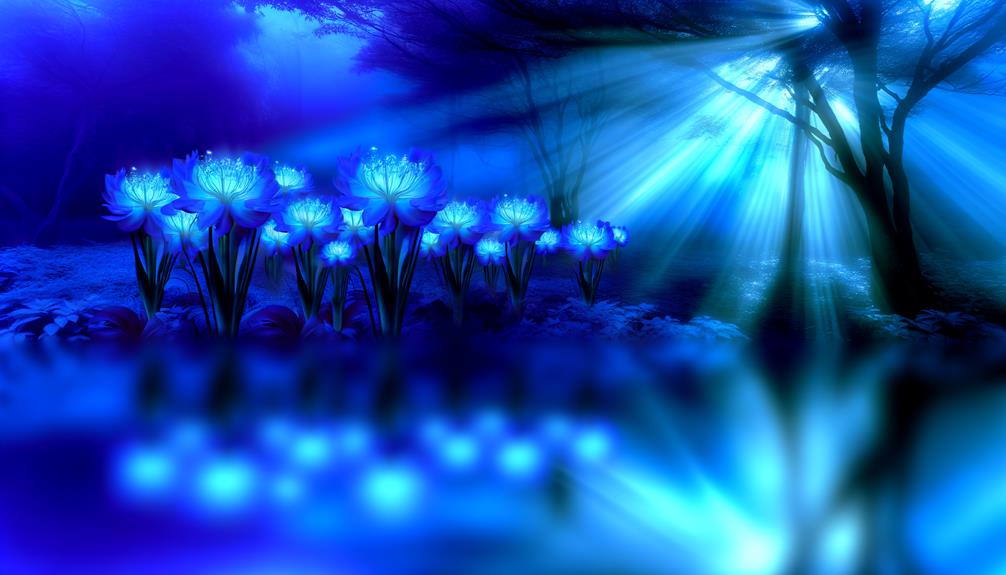
Spiritual Meaning of Blue Flowers: Peace, Intuition, and Divine Connection
| Blue Flower Type | Spiritual Meaning | Symbolism |
|---|---|---|
| Blue roses | Mystery and the unattainable | Quest for the divine and spiritual truth |
| Bluebells | Humility and everlasting love | Gratitude and devotion |
| Forget-me-nots | Remembrance and soul connection | Eternal bonds and spiritual memories |
| Cornflowers | Hope and renewal | New beginnings and spiritual growth |
| General blue flowers | Calmness and spiritual depth | Intuition, clarity, and serenity |
Symbolism in Different Cultures

Across various cultures, the ethereal beauty of blue flowers has been imbued with profound symbolic meanings that resonate with themes of tranquility, spirituality, and the divine.
In Eastern traditions, blue blossoms often symbolize enlightenment and the quest for inner peace, mirroring the serene expanse of the sky and ocean.
Western cultures, meanwhile, associate these flowers with calmness and contemplation, serving as gentle reminders of the soul’s higher aspirations.
Indigenous peoples have long revered them as sacred emblems of harmony and balance, reflecting the interconnection between humanity and nature.
Consequently, the mystical allure of blue flowers transcends geographical boundaries, inviting us to explore deeper spiritual truths and universal connections woven into the very fabric of existence.
Blue Flowers in Mythology
Throughout ancient mythologies, blue flowers have woven themselves into the sacred narratives of various cultures, symbolizing domains both earthly and divine.
Their ethereal hues are often linked to deities and mystical beings, embodying tranquility, wisdom, and the infinite.
Legends and folktales from around the world elevate these blossoms, imbuing them with meanings that transcend time and space.
Symbolism in Ancient Cultures
In ancient cultures, blue flowers were often regarded as sacred symbols, embodying the ethereal and the divine. Their rare, vivid hues captured the imagination, linking earthly existence with heavenly domains.
In Greek mythology, blue irises were seen as a bridge between gods and humans, guiding souls to the afterlife. Similarly, in ancient Egyptian lore, the blue lotus represented rebirth and immortality, blossoming each dawn from the sacred waters of the Nile.
These cultures perceived blue flowers not merely as botanical wonders but as conduits of spiritual insight. They reflected a yearning for transcendence, a desire to connect with the cosmic mysteries.
Therefore, blue flowers became timeless metaphors for the infinite, the unattainable, and the sublime.
Deities and Blue Flowers
Many deities across diverse mythological traditions have been associated with blue flowers, imbuing them with spiritual significance and mystical resonance.
In Hindu mythology, the blue lotus is sacred to Vishnu, symbolizing purity and transcendence. Similarly, in ancient Egyptian beliefs, the blue lotus was emblematic of the sun god Ra, representing creation and rebirth.
The Greeks revered the blue cornflower in connection with the goddess Flora, embodying the renewal of life and the beauty of nature.
These divine associations elevate blue flowers from mere botanical entities to celestial symbols, bridging the earthly and the divine. Such mythic connections invite us to ponder the deeper, often hidden meanings that these azure blooms carry within their delicate petals.
Legends and Folktales
Whispered through the ages, legends and folktales imbue blue flowers with enchanting narratives, where each petal holds a fragment of ancient wisdom and mystical lore.
In Celtic mythology, the bluebell is believed to be a portal to the fairy dimension, where time dances differently and mortal footsteps tread lightly.
German folklore tells of the Blue Flower, a symbol of desire and the unending quest for the unattainable, immortalized by the poet Novalis.
In Greek myth, the hyacinth sprang from the blood of Hyacinthus, a youth beloved by the gods, embodying themes of rebirth and eternal beauty.
Each story, a reflection of the ethereal allure of blue flowers, invites seekers to unravel hidden truths and embrace the mysteries of the natural world.
Peace and Tranquility
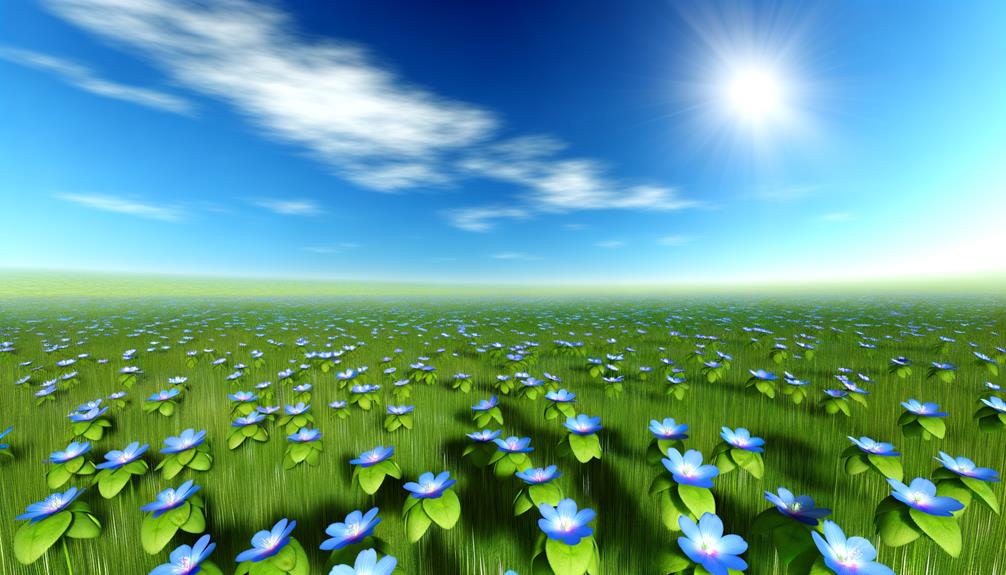
Blue flowers, with their serene hues, embody a universal symbol of peace and tranquility, resonating deeply within the human spirit.
Across various cultures, these blossoms are revered for their calming effect, often evoking a sense of inner serenity and spiritual harmony.
In their quiet elegance, blue flowers invite us to explore the tranquil spaces of our own consciousness, where stillness and reflection unite.
Calming Effect of Blue
The serene hue of blue flowers evokes a profound sense of peace and tranquility, inviting a calm that washes over the soul. This celestial color resonates with the inner sanctum of our being, fostering a serene ambiance that soothes mind and spirit.
As one gazes upon these ethereal blooms, an almost mystical quietude envelops the observer, guiding them to a state of reflective stillness. The gentle presence of blue flowers in our surroundings serves as a natural remedy against the chaos of daily life, offering a sanctuary of repose.
Their calming essence whispers a silent lullaby to the heart, encouraging a deeper connection with the tranquil rhythms of nature and the harmonious balance within ourselves.
Symbolism in Various Cultures
Across diverse cultures, the ethereal beauty of blue flowers often symbolizes peace and tranquility, reflecting a universal reverence for their calming essence. In various traditions, blue flowers are seen as emblems of serenity and spiritual calm, harmonizing the soul with nature’s profound quietude. This mystical resonance is captured in the table below:
| Culture | Symbolism |
|---|---|
| Japanese | Enlightenment and purity |
| Native American | Connection to the sky and water |
| European | Nostalgia and remembrance |
These symbolic meanings weave a tapestry of cultural spirituality, where blue flowers transcend mere physical beauty. They become serene whispers of nature, inviting a moment of reflection and inner peace. Their tranquility is a gentle reminder of the stillness that lies within us all.
In this realm of calm, the blue candle symbolism and intuition emerge as powerful allies, guiding us toward deeper self-awareness and understanding. Just as the blue flowers evoke serenity, the flickering light of a blue candle encourages introspection, illuminating the path to our innermost thoughts and feelings.
Together, they inspire a harmonious connection between the mind, spirit, and the natural world. As we gaze upon these delicate blooms, we are reminded of the interconnectedness of all living things, encouraging us to seek harmony within ourselves and our surroundings. The spiritual significance of teal color further deepens this experience, representing emotional balance and tranquility.
In their presence, we find not only solace but also an invitation to embrace the essence of our own spiritual journeys. Each blue flower, in its delicate form, serves as a conduit for deeper connections to our spiritual selves.
As we gaze upon their vibrant hues, we are reminded of the spiritual significance of blue candles, which represent healing, tranquility, and intuition. Together, these symbols encourage us to embrace moments of solitude and contemplation, fostering a sense of harmony in our bustling lives.
Connection to the Divine
In the delicate petals of blue flowers, one finds a profound symbol of spiritual ascension and a bridge to the divine.
These celestial blooms embody the essence of tranquility and introspection, guiding the soul towards higher domains of consciousness. Their azure hues evoke the infinite sky and the vastness of the ocean, both timeless metaphors for the divine expanse.
In meditative practices, blue flowers are cherished as conduits to deeper spiritual awareness, helping to quiet the mind and open the heart. They invite us to transcend earthly concerns and connect with the infinite wisdom of the universe, fostering a sense of unity with the cosmic flow.
Consequently, blue flowers serve as gentle reminders of our intrinsic connection to the divine.
Representations in Art
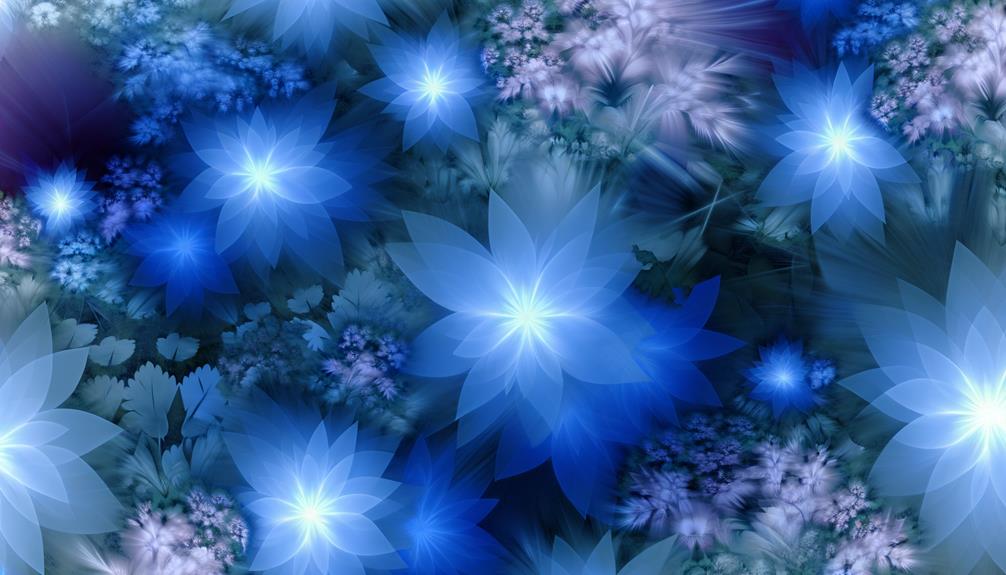
Depicting blue flowers in art has long been a mystical endeavor, capturing their ethereal beauty and spiritual symbolism with strokes of divine inspiration.
Artists, through the ages, have embraced the azure petals as emblems of transcendence, peace, and the infinite. The delicate brushwork that brings these blossoms to life often mirrors the inner journey toward enlightenment and self-discovery.
Blue flowers, painted with a touch of the sublime, evoke a sense of calm and otherworldly tranquility, acting as conduits between the earthly and the divine.
From the Romantic era’s preoccupation with the unattainable to modern abstract renditions, blue flowers continue to inspire a profound connection to the spiritual, inviting viewers to explore deeper domains of introspection and reverence.
Blue Flowers in Literature
Literature’s embrace of blue flowers often serves as a metaphorical tapestry, weaving together themes of yearning, mystery, and the quest for the sublime. From Novalis’s “Heinrich von Ofterdingen,” where the blue flower symbolizes poetic inspiration and an unattainable ideal, to the melancholic allure in Emily Dickinson’s verses, blue flowers evoke a sense of spiritual longing. They frequently appear as symbols of the infinite and elusive, guiding characters and readers alike on inner journeys of introspection and discovery.
“`markdown
| Author | Work Title |
|---|---|
| Novalis | Heinrich von Ofterdingen |
| Emily Dickinson | Selected Poems |
| Henry David Thoreau | Walden |
| William Wordsworth | The Prelude |
| Virginia Woolf | To the Lighthouse |
“`
This literary motif enriches texts with layers of meaning, inviting readers to explore the profound depths of human emotion and existential quest.
Healing and Spiritual Practices
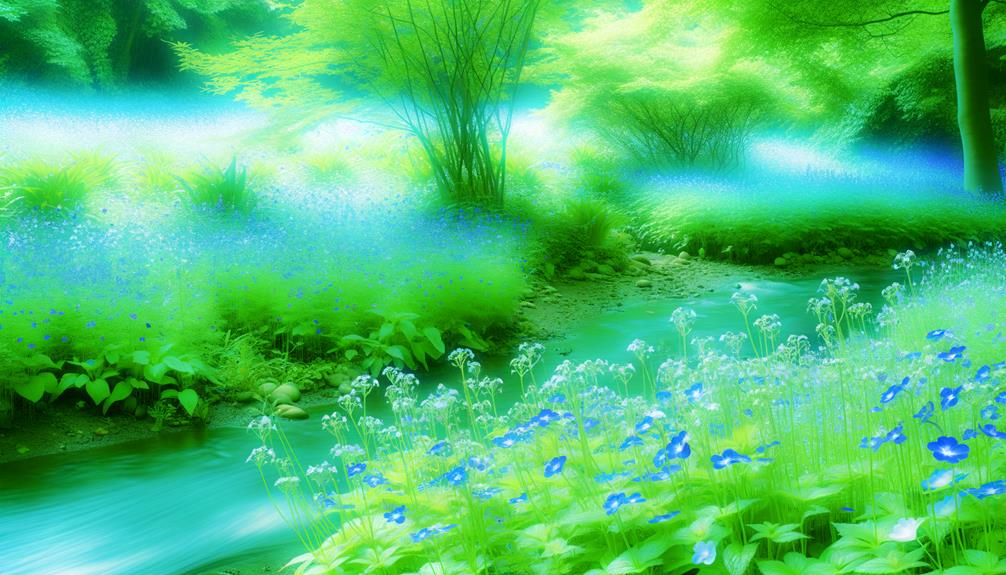
How do blue flowers, with their ethereal beauty and calming essence, manifest their significance in healing and spiritual practices?
Blue flowers, such as forget-me-nots and bluebells, resonate with the throat chakra, facilitating clear communication and emotional expression. Their soothing hues are believed to alleviate stress and promote tranquility, making them indispensable in holistic healing rituals.
In spiritual ceremonies, blue flowers embody divine wisdom and serenity, fostering a deeper connection to the celestial domain. The gentle vibration of blue petals enhances meditative states, inviting inner peace and reflection.
As symbols of trust and loyalty, they encourage the nurturing of spiritual bonds. Consequently, through their quiet elegance, blue flowers serve as conduits of healing and spiritual enlightenment. The blue lotus flower symbolism is particularly profound, representing spiritual rebirth and purity in many cultures.
By embodying the essence of serenity and tranquility, these flowers inspire individuals to seek inner peace and cultivate deeper connections with themselves and others. In moments of reflection, the gentle presence of blue flowers can guide one towards a more harmonious existence, fostering a sense of belonging in the universe.
Meditation and Reflection
The tranquil allure of blue flowers provides an ideal focal point for meditation, guiding the mind toward deeper states of introspection and spiritual awareness.
Their serene hue mirrors the vastness of the sky and the depth of the ocean, inviting practitioners to explore the boundless domains of their inner consciousness.
When one contemplates the delicate beauty of a blue blossom, a sense of calm and clarity emerges, facilitating a meditative state.
This practice allows individuals to transcend mundane concerns, fostering a profound connection with their higher self and the universe.
Blue flowers consequently serve as a mystical gateway, encouraging reflective moments that nurture the soul and enhance spiritual growth, aligning one’s essence with the harmony of nature.
Personal Transformation
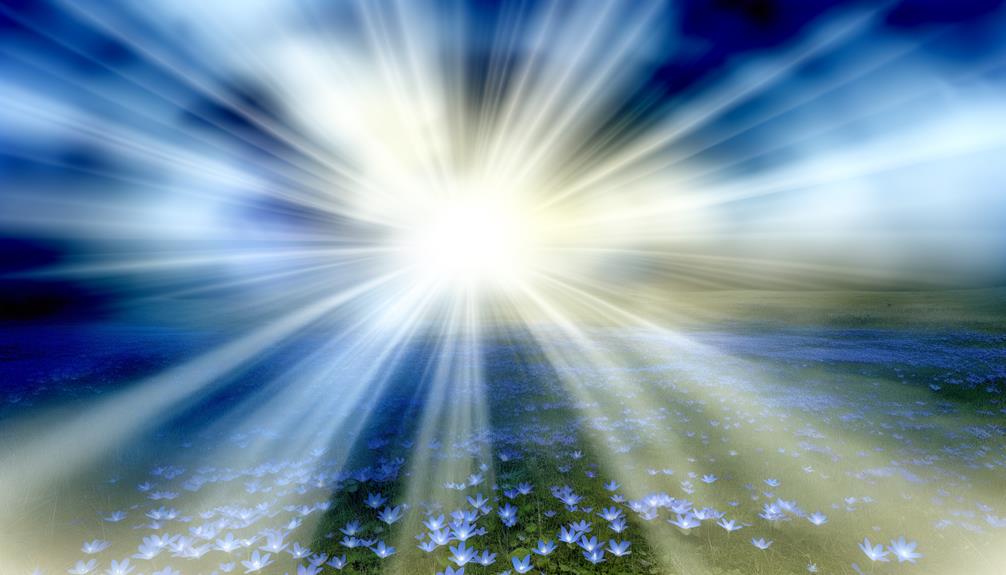
Immersing oneself in the serene beauty of blue flowers can ignite profound personal transformation, leading to a renewal of spirit and perspective. These celestial blooms serve as conduits for inner awakening, gently guiding the soul towards self-discovery and growth.
Blue flowers, with their tranquil hues, resonate with the throat chakra, promoting authentic expression and communication. As one contemplates their quiet elegance, barriers to self-awareness dissolve, revealing hidden truths and potentials.
The ethereal essence of these flowers encourages a journey inward, fostering resilience and clarity. In this sacred encounter, one finds the courage to transcend limitations, embracing a higher state of consciousness and spiritual evolution.
Consequently, blue flowers are not just botanical wonders, but catalysts for deep, meaningful change.
Conclusion
In the tapestry of human experience, blue flowers emerge as luminous threads, weaving through various cultures and epochs. They symbolize peace, divine connection, and personal transformation.
As vessels of tranquility and reflection, these blossoms serve as conduits to the mystical domains, embodying the essence of spiritual healing.
Through art, literature, and mythology, blue flowers stand as perennial symbols, inviting contemplation and a deeper understanding of the sacred dimensions of existence.

